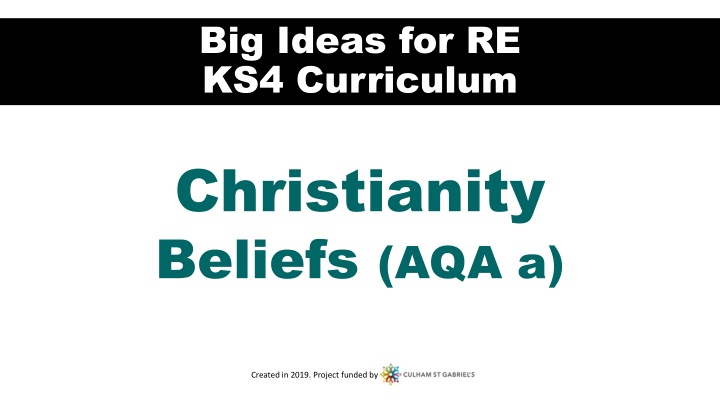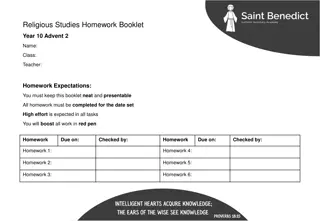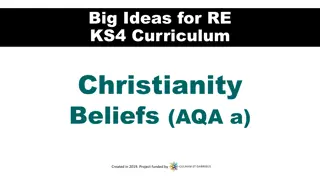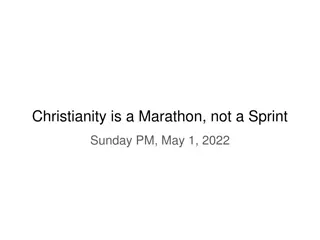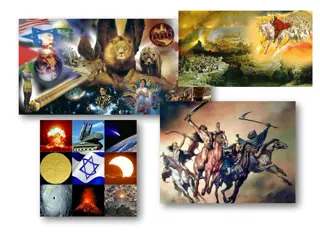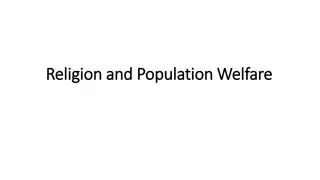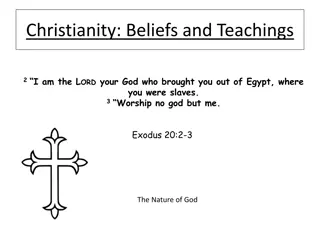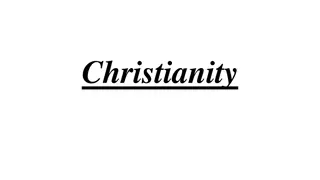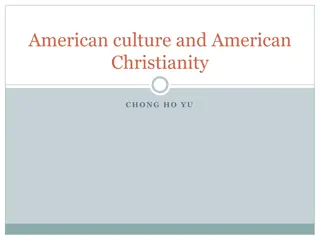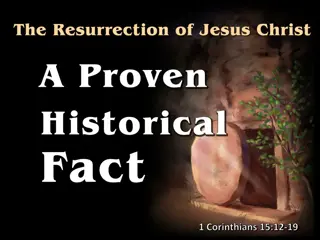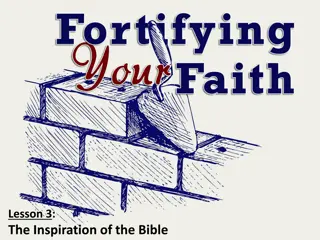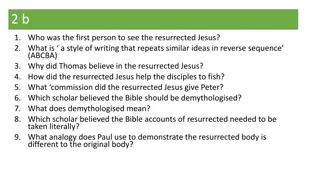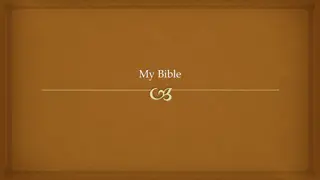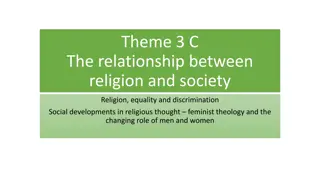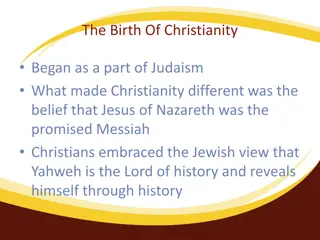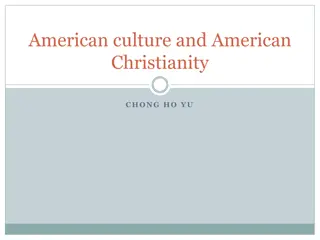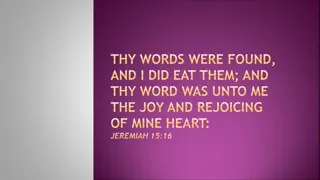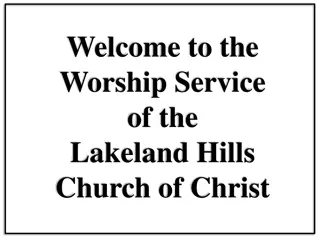Christianity: The Bible's Varied Interpretations
Within Christianity, the Bible can be interpreted in diverse ways, especially in the accounts of Genesis and creation. This project delves into different Christian perspectives on Genesis, exploring beliefs in the Trinity and the role of Word and Spirit. Students learn to discern between literal and non-literal readings of Genesis, emphasizing the original purpose of the text and how it supports Christian beliefs. Resources and engaging activities aid in this exploration, highlighting the significance of interpreting religious texts thoughtfully.
Download Presentation

Please find below an Image/Link to download the presentation.
The content on the website is provided AS IS for your information and personal use only. It may not be sold, licensed, or shared on other websites without obtaining consent from the author.If you encounter any issues during the download, it is possible that the publisher has removed the file from their server.
You are allowed to download the files provided on this website for personal or commercial use, subject to the condition that they are used lawfully. All files are the property of their respective owners.
The content on the website is provided AS IS for your information and personal use only. It may not be sold, licensed, or shared on other websites without obtaining consent from the author.
E N D
Presentation Transcript
Big Ideas for RE KS4 Curriculum Christianity Beliefs (AQA a) Created in 2019. Project funded by
3 3- -4: 4: Can the bible be read Can the bible be read differently within Christianity? differently within Christianity? BIG IDEAS LEARNING CONTEXT: brief recap about the nature of the Bible, Gen 1 and 2; what types of book, their message. DIVERSITY: different Christian interpretations of Genesis and creation BELIEFS: recap Trinity and creation, Christian beliefs about God From the spec beliefs about creation including the role of Word and Spirit (John 1:1 3 and Genesis 1:1 3). Different Christian Learning outcomes: Understand literal and non-literal ways of reading Genesis Explain original purpose of Genesis Explain how Christian readings of Genesis support belief in the Trinity RESOURCES 3 Gen 1-Gen 2:4 Online resource: http://www.cis.org.uk/wp- content/uploads/2011/10/Interpreting-Genesis.pdf If link is broken, search for How we interpret Genesis, Ernst Lucas
Lesson 3 1) Starter: students sort different statements into scientific and religious (next slide). 2) Ask students to say what science tells us and what religion tells us 3) Hand out small pieces of paper to groups with the following words on: night sky land day sea plants sun moon birds sea creatures 1st DAY 2ND DAY 3RD DAY 4TH DAY 5TH DAY 6TH DAY 7TH DAY Rest animals humans Ask 6 people to stand across the front holding the day numbers up. Read (or ask a student to read) Genesis 1- Genesis 2: 4. As you read, students bring their words to stand beside the corresponding day. 4) Can the class say how far the Judeo-Christian creation account is similar to an evolutionary order? 5) Discuss if the account in Genesis is scientific or religious. Ask groups to discuss the purpose of the Genesis account. Ask groups to discuss what information Genesis communicates 6) Read this online leaflet by Christian scholar of science Dr Ernst Lucas: http://www.cis.org.uk/wp- content/uploads/2011/10/Interpreting-Genesis.pdf . Either print out or read on screen. Highlight key points as you read (check on subsequent slide) 7) Return to questions about the purpose of religious sources. What purpose does Genesis serve for Jews and Christians? What purpose does it not serve?
Scientific statements, religious statements We should buy Fairtrade Henry VIII was a psychopath Life is suffering God is good God is a bully God exists Young children are creative thinkers because they don t worry about being wrong Life on other planets is mathematically probable Melons are related to cucumbers Humans are great apes Humans are made in the image of God Peace on earth is possible The universe is not infinite Prayer works Prayer does not work Religious people are happier
Thinking aboutHow we Interpret Genesis Dr Ernst Lucas Genesis is not a modern science book Genesis is thousands of years old It must be partly understood in terms of its original context Genesis communicates spiritual truths to Jews and Christians The sky described as a dome reflects the solid and reliable nature of God s creation Why are the sun and moon created on day 4, when light is created on day 1? Does this reflect God gradually building up order out of chaos? Genesis is not historical The Hebrew translation of good is fit for purpose Humans are put in a position of responsibility and privilege over creation
Lesson 4 1) Starter: to recap last lesson do a quick true/ false (next slide) 2) Read literal and non-literal readings of Genesis (subsequent slide). Create a 3-circle diagram summarizing literal and non-literal readings of Genesis, as well as a shared view of God (as on slide). Do this as a class or in groups, discussing and co-creating. 3) Recap Ask students to remind you what religion Jesus belonged to. Teach that in Jesus time, the Jewish religion was hundreds of years old [teacher notes: Genesis was written in the 5th or 6th Century BCE, taken from an earlier oral (spoken) tradition. By around 800- 200 BCE Jews were confirmed monotheists. Genesis was written for a pre-Christian, middle Eastern audience.] 4) Return to Ernst Lucas leaflet on Genesis. Ask the class to suggest reasons why the sun and the moon appear after light in Genesis? Read Lucas s answer: because the ancient Middle Eastern tribes worshipped them as gods. The Genesis account sets the God of Judaism, Yahweh, as the creator of everything, including these so called gods . 5) Teach that, in fact, Genesis borrows from an earlier Mesopotamian creation account called the Enuma Elish. However whereas the god in the Enuma Elish physicallyfights chaos to bring about order, Yahweh merely speaks and it happens. Ask groups suggest what Genesis would have told ancient Jewish tribes about their God, Yahweh.
Lesson 4 continued 6) Read Gen 1: 1-4 (on 3 Gen 1- 2:4 sheet). 7) Recap the persons of the Trinity- who are they? Write father, son, spirit on board. Can the class find any hints of Trinitarian thinking in these lines? 8) Ask groups to re-read Gen 1-2.4 and identify anything here that later Christians could use to support their belief in the Trinity 9) Find an image online of God creating Adam from Michelangelo's Sistine Chapel ceiling (see subsequent slides). Behind God is a woman and a baby. These are believed to be Mary and Jesus. Choose from the statements on the slide what students think this means. Discuss. 10)Read John 1: 1-3 (slide). John wrote his gospel once Jesus followers had become convinced of his divinity. Ask groups to discuss what key role does John seems to give Jesus with regards to creation? Does Michelangelo appear to support or disagree with John? 11)Discuss as a class how (a) Jews and Christians can read Genesis differently and (b) Christians can read Genesis in a literal or non-literal way.
True or false??? Genesis is an early science book Genesis explains evolution Genesis is the first book in the bible The Genesis account is also in the Qur an Genesis is a poem Genesis is 1000s of years old Christians have to believe Genesis is literally true
Reading Genesis Non-literal Reading Genesis is not literally true It is not a historical or scientific account Genesis is a poem or song to an incredibly powerful God God is the root cause of creation God cares about humans and creation Scientific accounts, such as Big Bang and evolution theory, are reliable explanations for HOW the universe and life came to be Each day in Genesis might symbolize a period of time rather than exactly 24 hours Literal Reading The creation account in Genesis is literally true It is an historical account The world was created in 6 days Each day lasts for 24 hours Shared view of God Literal reading of Genesis Non-literal reading of Genesis
Image reference: Image reference: https://unsplash.com/photos/y8b001e2bs0
WHAT DOES THIS MEAN? - Jesus is part of God - Jesus is not an afterthought- he is present from the beginning - God s time is not linear - Mary s role was known from the beginning - Michelangelo believes Jesus (and Mary) to have been present from the beginning of time Image reference: Image reference: https://pixabay.com/phot https://pixabay.com/phot os/sistine os/sistine- -chapel chapel- -vatican michelangelo michelangelo- -1128852/ Michelangelo God creating Adam (Sistine chapel) vatican- - 1128852/
Gen 1: 1-3 In the beginning, when God created the universe,the earth was formless and desolate. The raging ocean that covered everything was engulfed in total darkness, and the Spirit of God was moving over the water. Then God commanded, Let there be light and light appeared. John 1: 1-3 In the beginning the Word already existed; the Word was with God, and the Word was God.From the very beginning the Word was with God. Through him God made all things; not one thing in all creation was made without him. Other translations of spirit : the Spirit of God; the power of God; a wind from God; an awesome wind. John uses a Greek word logos which can be translated as Word . Jesus is the Word made flesh to Christians. Substitute every use of Word for Jesus
